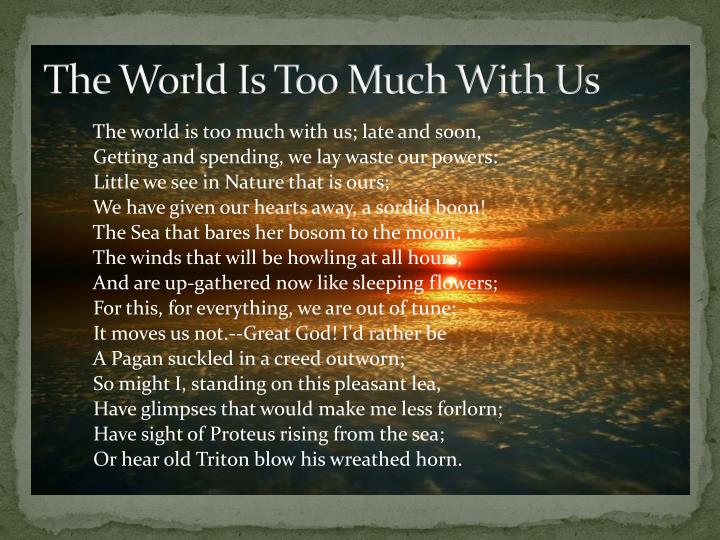

Description of the Child and its Surroundingsģ.2. The Children in the Poems ‘We are Seven’ and ‘Anecdote for Fathers’ģ.1.

Childhood in Romanticism – A Short Surveyģ. You can find the complete poetical works of William Wordsworth here.2. Curiously for a poet whose work points so directly toward the future, many of Wordsworth’s important works are preoccupied with the lost glory of the past-not only of the lost dreams of childhood but also of the historical past, as in the powerful sonnet “London, 1802,” in which the speaker exhorts the spirit of the centuries-dead poet John Milton to teach the modern world a better way to live. More than any poet before him, Wordsworth gave expression to inchoate human emotion his lyric “Strange fits of passion have I known,” in which the speaker describes an inexplicable fantasy he once had that his lover was dead, could not have been written by any previous poet. Wordsworth’s poems initiated the Romantic era by emphasizing feeling, instinct, and pleasure above formality and mannerism. Wordsworth’s images and metaphors mix natural scenery, religious symbolism (as in the sonnet “It is a beauteous evening, calm and free,” in which the evening is described as being “quiet as a nun”), and the relics of the poet’s rustic childhood-cottages, hedgerows, orchards, and other places where humanity intersects gently and easily with nature. Many of Wordsworth’s poems (including masterpieces such as “Tintern Abbey” and the “Intimations of Immortality” ode) deal with the subjects of childhood and the memory of childhood in the mind of the adult in particular, childhood’s lost connection with nature, which can be preserved only in memory. Wordsworth’s style remains plain-spoken and easy to understand even today, though the rhythms and idioms of common English have changed from those of the early nineteenth century. Recovering “the naked and native dignity of man” makes up a significant part of Wordsworth’s poetic project, and he follows his own advice from the 1802 preface.

And he argues that the first principle of poetry should be pleasure, that the chief duty of poetry is to provide pleasure through a rhythmic and beautiful expression of feeling-for all human sympathy, he claims, is based on a subtle pleasure principle that is “the naked and native dignity of man.” Here, Wordsworth argues that poetry should be written in the natural language of common speech, rather than in the lofty and elaborate dictions that were then considered “poetic.” He argues that poetry should offer access to the emotions contained in memory. But the themes that run through Wordsworth’s poetry, and the language and imagery he uses to embody those themes, remain remarkably consistent throughout the Wordsworth canon, adhering largely to the tenets Wordsworth set out for himself in the 1802 preface to Lyrical Ballads. Wordsworth’s monumental poetic legacy rests on a large number of important poems, varying in length and weight from the short, simple lyrics of the 1790s to the vast expanses of The Prelude, thirteen books long in its 1808 edition.


 0 kommentar(er)
0 kommentar(er)
